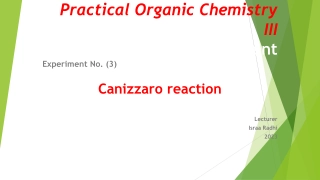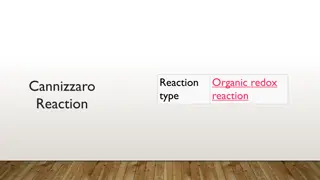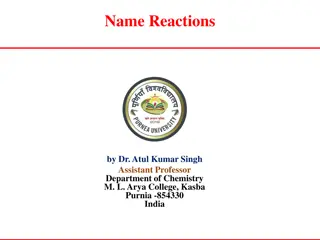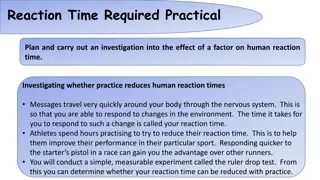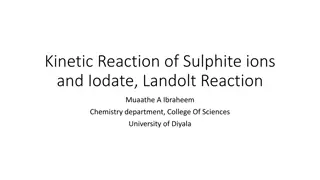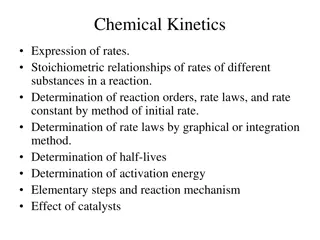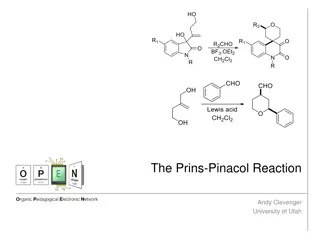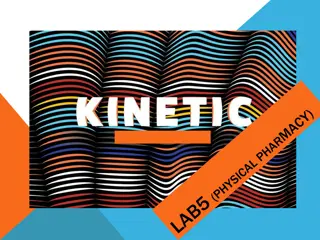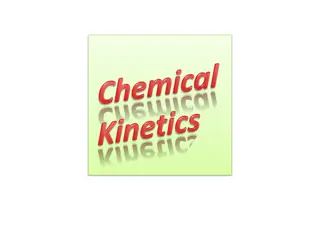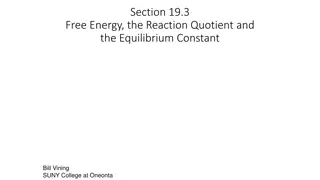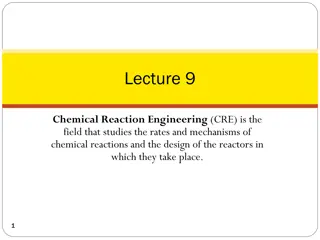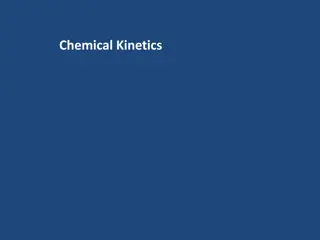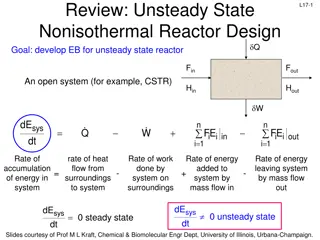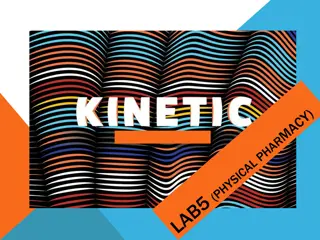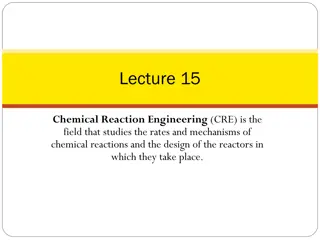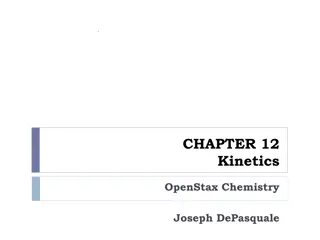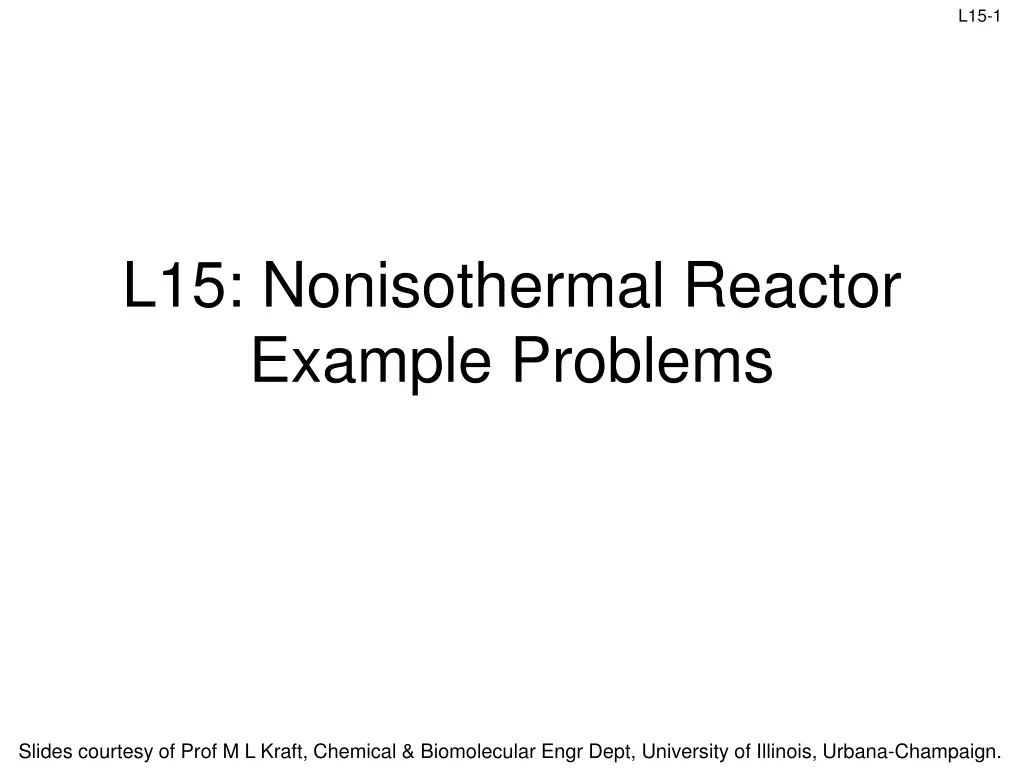
Nonisothermal Reactor Example Problems Slides
Explore example problems related to nonisothermal reactors, including multiple steady states in CSTR, heat removal terms, and CSTR stability. Understand how intersections of mass and energy balance equations result in multiple steady states, the impact of heat exchange on reactor behavior, and stability analysis based on heat generation and removal rates.
Download Presentation

Please find below an Image/Link to download the presentation.
The content on the website is provided AS IS for your information and personal use only. It may not be sold, licensed, or shared on other websites without obtaining consent from the author. If you encounter any issues during the download, it is possible that the publisher has removed the file from their server.
You are allowed to download the files provided on this website for personal or commercial use, subject to the condition that they are used lawfully. All files are the property of their respective owners.
The content on the website is provided AS IS for your information and personal use only. It may not be sold, licensed, or shared on other websites without obtaining consent from the author.
E N D
Presentation Transcript
L15-1 L15: Nonisothermal Reactor Example Problems Slides courtesy of Prof M L Kraft, Chemical & Biomolecular Engr Dept, University of Illinois, Urbana-Champaign.
Review: Multiple Steady States in CSTR 1 L15-2 XA,EB XA,MB 0.8 0.6 XA 0.4 0.2 0 0 100 200 300 T (K) 400 500 600 Plot of XA,EB vs T and XA,MB vs T Intersections are the T and XA that satisfy both mass balance (MB) & energy balance (EB) equations Each intersection is a steady state (temperature & conversion) Multiple sets of conditions are possible for the same reaction in the same reactor with the same inlet conditions! Slides courtesy of Prof M L Kraft, Chemical & Biomolecular Engr Dept, University of Illinois, Urbana-Champaign.
L15-3 Review: Heat Removal Term R(T) & T0 Heat removed: R(T) Heat generated G(T) + T 1 T = a 0 UA C F = T p0 A0 r V F c ) + ( A + = C 1 T T H p0 C RX A0 R(T) line has slope of CP0(1+ ) = R(T) = 0 R(T) Increase For Ta < T0 Increase T0 Ta T0 T When increases from lowering FA0 or increasing heat exchange, slope and x-intercept moves Ta<T0: x-intercept shifts left as Ta>T0: x-intercept shifts right as =0, then TC=T0 = , then TC=Ta T When T0 increases, slope stays same & line shifts to right Slides courtesy of Prof M L Kraft, Chemical & Biomolecular Engr Dept, University of Illinois, Urbana-Champaign.
L15-4 Review: CSTR Stability + T 1 T G(T) > R(T) T rises to T=SS3 = UA C F G(T) a 0 p0 A0 = T c + R(T) 3 R(T) > G(T) R(T) > G(T) T falls to T=SS1 T falls to T=SS3 G(T) > R(T) T rises to T=SS1 2 Heat generated G(T) Heat removed: R(T) r V F ) ( A + = C 1 T T H 1 p0 C RX A0 T Magnitude of G(T) to R(T) curve determines if reactor T will rise or fall G(T) = R(T) intersection, equal rate of heat generation & removal, no change in T G(T) > R(T) (G(T) line above R(T) on graph): rate of heat generation > heat removal, so reactor heats up until a steady state is reached R(T) > G(T) (R(T) line above G(T) on graph): rate of heat generation < heat removal, so reactor cools off until a steady state is reached Slides courtesy of Prof M L Kraft, Chemical & Biomolecular Engr Dept, University of Illinois, Urbana-Champaign.
The elementary irreversible reaction A + B C is carried out adiabatically in a flow reactor with S=0. An equal molar feed of A & B enters at 300K with 0 = 2 dm3/s and CA0 = 0.1 mol/dm3. What is the PFR & CSTR volume required to achieve XA=0.85? Extra info: liquid phase rxn CpA=CpB=15 cal/mol K CpC= 30 cal/mol E = 10,000 cal/mol HA (273K)= -20 kcal/mol HB (273K)= -15 kcal/mol HC (273K)= -41 kcal/mol 3 k 0.01 dm mol s at 300K = Strategy: L15-5 1. 2. 3. 4. 5. 6. 6a. Solve CSTR i. Use EB to find T as a function of XA ii. Calculate V using the CSTR design eq with k calculated at that T Mole balance Rate Law Stoichiometry Combine rate law & stoichiometry Energy balance Solve 6b. Solve PFR i. Use EB to construct table of T as a function of XA ii. Use k = Ae-E/RT to construct table of k as function of T & therefore XA iii. Calculate -rA as a function of T & XA iv. Calculate FA0/-rA for each T v. Use numeric technique to calculate V Slides courtesy of Prof M L Kraft, Chemical & Biomolecular Engr Dept, University of Illinois, Urbana-Champaign.
L15-6 The elementary irreversible reaction A + B C is carried out adiabatically in a flow reactor with S=0. An equal molar feed of A & B enters at 300K with 0 = 2 dm3/s and CA0 = 0.1 mol/dm3. What is the PFR & CSTR volume required to achieve XA=0.85? Extra info: CpA=CpB=15 cal/mol K CpC= 30 cal/mol E = 10,000 cal/mol HA (273K)= -20 kcal/mol HB (273K)= -15 kcal/mol HC (273K)= -41 kcal/mol 3 k 0.01 dm mol s at 300K = CSTR PFR 0.85 = F X r F A0 A A0 r = CSTR V PFR V dX Mole balance A A A 0 = r kC C Rate law A A B 3 dm mol s 10000cal mol 1.987cal mol K 300K 1 1 T = k 0.01 exp ( ) = = 1 X C C C Stoichiometry B A A0 A 10000 1 1 T )2 ( 2 Combine: = 1 X r 0.01exp C A A0 A 1.987cal mol K 300K Slides courtesy of Prof M L Kraft, Chemical & Biomolecular Engr Dept, University of Illinois, Urbana-Champaign.
L15-7 The elementary irreversible reaction A + B C is carried out adiabatically in a flow reactor with S=0. An equal molar feed of A & B enters at 300K with 0 = 2 dm3/s and CA0 = 0.1 mol/dm3. What is the PFR & CSTR volume required to achieve XA=0.85? Extra info: CpA=CpB=15 cal/mol K CpC= 30 cal/mol E = 10,000 cal/mol HA (273K)= -20 kcal/mol HB (273K)= -15 kcal/mol HC (273K)= -41 kcal/mol 3 k 0.01 dm mol s at 300K = Combine MB, rate law & stoichiometry for CSTR: A0 F X r A = V CSTR A A0 0 C X A = CSTR V 3 dm mol s 10000cal mol 1.987cal mol K 300K 1 1 T 2 ( ) 2 1 X 0.01 exp C A0 A X 0 A = CSTR V 3 dm mol s 1 1 T 2 ( ) 1 X 0.01 exp 5032.7K C A0 A 300K Slides courtesy of Prof M L Kraft, Chemical & Biomolecular Engr Dept, University of Illinois, Urbana-Champaign.
L15-8 The elementary irreversible reaction A + B C is carried out adiabatically in a flow reactor with S=0. An equal molar feed of A & B enters at 300K with 0 = 2 dm3/s and CA0 = 0.1 mol/dm3. What is the PFR & CSTR volume required to achieve XA=0.85? Extra info: CpA=CpB=15 cal/mol K CpC= 30 cal/mol E = 10,000 cal/mol HA (273K)= -20 kcal/mol HB (273K)= -15 kcal/mol HC (273K)= -41 kcal/mol 3 k 0.01 dm mol s at 300K = Energy balance Solve for T: n = i p,i C 0 Q W F T T H (T)F X s 0 A0 i0 RX A0 A i 1 = 0 n Substitute: i p,i C = A0 F T T H (T)F X ( ) i0 RX A0 A = + H H (T ) C T T RX RX R ) P R i 1 = n ( i p,i C = + T T H (T ) C T T X i0 RX R P R A i 1 = Multiply out quantities in brackets, bring T to 1 side of equation, factor out T, divide by quantity in bracket: Evaluate Cp: n i p,i i0 C T P R C T X + H (T )X = RX R A A C C C C P pC pA pB i 1 = = T n cal ( ) i p,i C + C X = 30 15 15 = C 0 P A P mol K i 1 = Slides courtesy of Prof M L Kraft, Chemical & Biomolecular Engr Dept, University of Illinois, Urbana-Champaign.
L15-9 The elementary irreversible reaction A + B C is carried out adiabatically in a flow reactor with S=0. An equal molar feed of A & B enters at 300K with 0 = 2 dm3/s and CA0 = 0.1 mol/dm3. What is the PFR & CSTR volume required to achieve XA=0.85? Extra info: CpA=CpB=15 cal/mol K CpC= 30 cal/mol E = 10,000 cal/mol HA (273K)= -20 kcal/mol HB (273K)= -15 kcal/mol HC (273K)= -41 kcal/mol 3 k 0.01 dm mol s at 300K = Energy balance n = + i p,i i0 C T H (T )X C T X RX R A P R A H (T )X = C 0 i 1 = RX n R A P = + T T T i0 n i p,i C + i p,i C C X P A i 1 = i 1 = Evaluate iCp: = B0 F F n cal cal ( ) = = 1 i pi C = + = 15 15 + = 1 C C 30 B A pA pB mol K mol K i 1 = A0 Evaluate H RX(TR): ( ) RX R H T cal mol cal mol ( ) ( ) ( ) = = 41000 = H H H 20000 15000 6000 C A B ( ) 6000cal mol X 30cal mol K ( ) A = + = + T 300K T 300K 200K X Simplify EB: A Slides courtesy of Prof M L Kraft, Chemical & Biomolecular Engr Dept, University of Illinois, Urbana-Champaign.
L15-10 The elementary irreversible reaction A + B C is carried out adiabatically in a flow reactor with S=0. An equal molar feed of A & B enters at 300K with 0 = 2 dm3/s and CA0 = 0.1 mol/dm3. What is the PFR & CSTR volume required to achieve XA=0.85? Extra info: CpA=CpB=15 cal/mol K CpC= 30 cal/mol E = 10,000 cal/mol HA (273K)= -20 kcal/mol HB (273K)= -15 kcal/mol HC (273K)= -41 kcal/mol 3 k 0.01 dm mol s at 300K = Solve for CSTR volume: use EB to find T when XA=0.85 ( ) A T 300K 200K X = + ( ) = + = T 300K 200K 0.85 T 470K X 0 A = CSTR V 3 dm mol s 1 1 T 2 ( ) 1 X 0.01 exp 5032.7K C A0 A 300K 3 dm 2 0.85 s = CSTR V 3 dm mol s 1 1 mol dm 2 ( ) 1 0.85 0.01 exp 5032.7K 0.1 3 300K 470K = CSTR V 175L Slides courtesy of Prof M L Kraft, Chemical & Biomolecular Engr Dept, University of Illinois, Urbana-Champaign.
L15-11 The elementary irreversible reaction A + B C is carried out adiabatically in a flow reactor with S=0. An equal molar feed of A & B enters at 300K with 0 = 2 dm3/s and CA0 = 0.1 mol/dm3. What is the PFR & CSTR volume required to achieve XA=0.85? Solve for PFR: i. Use EB to construct table of T as a function of XA(We re interested in range where XA = 0 to XA = 0.85) ( ) ( ) = + = = + T 300K 200K 0 300K T 300K 200K X A XA 0 0.2 0.4 0.6 0.8 0.85 T (K) 300 k (dm3/mol s) -rA (mol/dm3 s) FA0/-rA (dm3) Slides courtesy of Prof M L Kraft, Chemical & Biomolecular Engr Dept, University of Illinois, Urbana-Champaign.
L15-12 The elementary irreversible reaction A + B C is carried out adiabatically in a flow reactor with S=0. An equal molar feed of A & B enters at 300K with 0 2 dm3/s and CA0 = 0.1 mol/dm3. What is the PFR & CSTR volume required to achieve XA=0.85? Solve for PFR: i. Use EB to construct table of T as a function of XA -Temperature range should cover XA = 0 to XA = 0.85 ( ) = + T 300K 200K X A XA 0 0.2 0.4 0.6 0.8 0.85 Calculate k(T) for each T in the table 3 dm k 0.01 exp 5032.7K mol s T (K) 300 340 380 420 460 470 k (dm3/mol s) -rA (mol/dm3 s) FA0/-rA (dm3) ii. 1 1 T = 300K Slides courtesy of Prof M L Kraft, Chemical & Biomolecular Engr Dept, University of Illinois, Urbana-Champaign.
L15-13 The elementary irreversible reaction A + B C is carried out adiabatically in a flow reactor with S=0. An equal molar feed of A & B enters at 300K with 0 = 2 dm3/s and CA0 = 0.1 mol/dm3. What is the PFR & CSTR volume required to achieve XA=0.85? Solve for PFR: i. Use EB to construct table of T as a function of XA -Temperature range should cover XA = 0 to XA = 0.85 ( ) = + T 300K 200K X A XA 0 0.2 0.4 0.6 0.8 0.85 T (K) 300 340 380 420 460 470 k (dm3/mol s) 0.01 0.072 0.34 1.21 3.42 4.31 -rA (mol/dm3 s) FA0/-rA (dm3) ii. Calculate k(T) for each T in the table 3 dm k 0.01 exp 5032.7K mol s 1 1 T = 300K Slides courtesy of Prof M L Kraft, Chemical & Biomolecular Engr Dept, University of Illinois, Urbana-Champaign.
L15-14 The elementary irreversible reaction A + B C is carried out adiabatically in a flow reactor with S=0. An equal molar feed of A & B enters at 300K with 0 = 2 dm3/s and CA0 = 0.1 mol/dm3. What is the PFR & CSTR volume required to achieve XA=0.85? Solve for PFR: i. Use EB to construct table of T as a function of XA -Temperature range should cover XA = 0 to XA = 0.85 ii. Calculate k(T) XA 0 0.2 0.4 0.6 0.8 0.85 Calculate rA each XA and k in the table T (K) 300 340 380 420 460 470 k (dm3/mol s) 0.01 0.072 0.34 1.21 3.42 4.31 -rA (mol/dm3 s) FA0/-rA (dm3) iii. 2 3 dm mol s mol dm mol dm 2 ( ) )2 ( 2 = 1 0 = r 0.01 0.1 0.0001 = 1 X r kC A A A0 A 3 3 s Slides courtesy of Prof M L Kraft, Chemical & Biomolecular Engr Dept, University of Illinois, Urbana-Champaign.
L15-15 The elementary irreversible reaction A + B C is carried out adiabatically in a flow reactor with S=0. An equal molar feed of A & B enters at 300K with 0 = 2 dm3/s and CA0 = 0.1 mol/dm3. What is the PFR & CSTR volume required to achieve XA=0.85? Solve for PFR: i. Use EB to construct table of T as a function of XA -Temperature range should cover XA = 0 to XA = 0.85 ii. Calculate k(T) XA 0 0.2 0.4 0.6 0.8 0.85 Calculate rA each XA and k in the table T (K) 300 340 380 420 460 470 k (dm3/mol s) 0.01 0.072 0.34 1.21 3.42 4.31 -rA (mol/dm3 s) 0.0001 0.00046 0.00122 0.00194 0.0014 0.00097 FA0/-rA (dm3) iii. 2 3 dm mol s mol dm mol dm 2 ( ) )2 ( 2 = 1 0 = r 0.01 0.1 0.0001 = 1 X r kC A A A0 A 3 3 s Slides courtesy of Prof M L Kraft, Chemical & Biomolecular Engr Dept, University of Illinois, Urbana-Champaign.
L15-16 The elementary irreversible reaction A + B C is carried out adiabatically in a flow reactor with S=0. An equal molar feed of A & B enters at 300K with 0 2 dm3/s and CA0 = 0.1 mol/dm3. What is the PFR & CSTR volume required to achieve XA=0.85? Solve for PFR: i. Use EB to construct table of T as a function of XA -Temperature range should cover XA = 0 to XA = 0.85 ii. Calculate k(T) iii. Calculate rA each XA and k in the table XA 0 0.2 0.4 0.6 0.8 0.85 Calculate FA0/ rA for each XA in the table = = T (K) 300 340 380 420 460 470 k (dm3/mol s) 0.01 0.072 0.34 1.21 3.42 4.31 -rA (mol/dm3 s) 0.0001 0.00046 0.00122 0.00194 0.0014 0.00097 FA0/-rA (dm3) iii. 3 mol dm dm mol s A0 0 = F C 0.1 2 0.2 A0 3 s Slides courtesy of Prof M L Kraft, Chemical & Biomolecular Engr Dept, University of Illinois, Urbana-Champaign.
L15-17 The elementary irreversible reaction A + B C is carried out adiabatically in a flow reactor with S=0. An equal molar feed of A & B enters at 300K with 0 = 2 dm3/s and CA0 = 0.1 mol/dm3. What is the PFR & CSTR volume required to achieve XA=0.85? Solve for PFR: i. Use EB to construct table of T as a function of XA -Temperature range should cover XA = 0 to XA = 0.85 ii. Calculate k(T) iii. Calculate rA each XA and k in the table XA 0 0.2 0.4 0.6 0.8 0.85 Calculate FA0/ rA for each XA in the table = = T (K) 300 340 380 420 460 470 k (dm3/mol s) 0.01 0.072 0.34 1.21 3.42 4.31 -rA (mol/dm3 s) 0.0001 0.00046 0.00122 0.00194 0.0014 0.00097 FA0/-rA (dm3) 2000 434.8 163.9 103.1 142.9 206.2 iii. 3 mol dm dm mol s A0 0 = F C 0.1 2 0.2 A0 3 s Slides courtesy of Prof M L Kraft, Chemical & Biomolecular Engr Dept, University of Illinois, Urbana-Champaign.
L15-18 The elementary irreversible reaction A + B C is carried out adiabatically in a flow reactor with S=0. An equal molar feed of A & B enters at 300K with 0 = 2 dm3/s and CA0 = 0.1 mol/dm3. What is the PFR & CSTR volume required to achieve XA=0.85? Solve for PFR: XA 0 0.2 0.4 0.6 0.8 0.85 T (K) 300 340 380 420 460 470 k (dm3/mol s) 0.01 0.072 0.34 1.21 3.42 4.31 -rA (mol/dm3 s) 0.0001 0.00046 0.00122 0.00194 0.00137 0.00097 FA0/-rA (dm3) 2000 434.8 163.9 103.1 146 206.2 Numeric evaluation by parts: 5-point rule for XA interval 0 to 0.8, 2-point rule for XA interval from 0.8 to 0.85: ( ) ( ) 0 1 2 X 0 4 X X ( ) 5 h 3 h 4 = h X X 4 1 2 1 4 0 + = + + + + + + f X dx f X dx f 4f 2f 4f f f f 3 4 4 5 2 = h X X X 2 5 4 0.2 3 0.05 2 ( ) ( V ) ( ) = + + + + + + PFR V 2000 4 434.8 2 163.9 4 103.1 146 146 206.2 = 317L PFR Slides courtesy of Prof M L Kraft, Chemical & Biomolecular Engr Dept, University of Illinois, Urbana-Champaign.
L15-19 For these conditions, what is the max T0 that would keep T 550K at complete conversion? H (T )X RX n R A n cal = + cal T T ( ) i0 i pi C = = 30mol K H T 6000mol RX R i p,i C i 1 = i 1 = cal mol cal 6000 X A ( ) = + = + T T 200K X T T i0 A i0 30mol K T 550K at complete conversion, XA=1: ( ) + 550K T 200K 1 350K T i0 i0 Max T0 is 350K Slides courtesy of Prof M L Kraft, Chemical & Biomolecular Engr Dept, University of Illinois, Urbana-Champaign.
L15-20 The first order irreversible reaction A(l) B(l) is carried out in a jacketed CSTR. The feed contains A and an inert liquid in equimolar amounts, where FA0 = 80 mol/min. What is the reactor temp when the inlet temp T0 is 450K? UA= 8000 cal/min K Ta= 300K HRX=-7500 cal/mol CpA = CpB =20 cal/mol K Cpi =30 cal/mol K =100 min E=40,000 cal/mol k=6.6 x 10-3 min-1 at 350K Need to find where G(T)=R(T) for T0 = 450K 1. Put R(T) & G(T) in terms of constants in the problem statement 2. Plot R(T) vs T and G(T) vs T on the same graph & find where they intersect ( ) ( ) = + p C 0 R T C 1 T T r V F ( ) A = G T H + T 1 T RX = a 0 UA C F = T p0 A0 A0 c + Slides courtesy of Prof M L Kraft, Chemical & Biomolecular Engr Dept, University of Illinois, Urbana-Champaign.
L15-21 The first order irreversible reaction A(l) B(l) is carried out in a jacketed CSTR. The feed contains A and an inert liquid in equimolar amounts, where FA0 = 80 mol/min. What is the reactor temp when the inlet temp T0 is 450K? UA= 8000 cal/min K Ta= 300K HRX=-7500 cal/mol CpA = CpB =20 cal/mol K Cpi =30 cal/mol K =100 min E=40,000 cal/mol k=6.6 x 10-3 min-1 at 350K A I B I + + Put R(T) in terms of constants in the problem statement, starting with CP0: I = inert + T 1 T ) ( ) ( = + a 0 R T C 1 T T = = UA C F T p0 C p 0 A 0 c + n cal = = 1 = + = = = + C 20 30 50mol K C i pi C C C I pI C A I p0 p0 p0 A pA = i 1 Put in terms of constants from the problem statement: 8000cal min K UA = = 2 = cal mol min C F 5 0mol K 80 p 0 A 0 Put TC in terms of constants in the problem statement: ( ) + + 2 300K 450K T 1 T a 0 = = = T 350K T T c c c + + 1 2 Slides courtesy of Prof M L Kraft, Chemical & Biomolecular Engr Dept, University of Illinois, Urbana-Champaign.
L15-22 The first order irreversible reaction A(l) B(l) is carried out in a jacketed CSTR. The feed contains A and an inert liquid in equimolar amounts, where FA0 = 80 mol/min. What is the reactor temp when the inlet temp T0 is 450K? UA= 8000 cal/min K Ta= 300K HRX=-7500 cal/mol CpA = CpB =20 cal/mol K Cpi =30 cal/mol K =100 min E=40,000 cal/mol k=6.6 x 10-3 min-1 at 350K A I B I + + I = inert Find steady state temp [G(T)=R(T) ] for T0 = 450K ( ) ( ) = + p0 R T 1 T C cal = T = T 350K C 50mol K = 2 C c p0 Plug and Tc into R(T): ( ) = R T cal ) ) ( ) T ( ( = + + R 50mol 1 2 T 350K C 1 T T p0 C K cal cal mol ( ) = R T 150 T 52500 mol K Slides courtesy of Prof M L Kraft, Chemical & Biomolecular Engr Dept, University of Illinois, Urbana-Champaign.
L15-23 The first order irreversible reaction A(l) B(l) is carried out in a jacketed CSTR. The feed contains A and an inert liquid in equimolar amounts, where FA0 = 80 mol/min. What is the reactor temp when the inlet temp T0 is 450K? UA= 8000 cal/min K Ta= 300K HRX=-7500 cal/mol CpA = CpB =20 cal/mol K Cpi =30 cal/mol K =100 min E=40,000 cal/mol k=6.6 x 10-3 min-1 at 350K A I B I + + I = inert Find steady state temp [G(T)=R(T) ] for T0 = 450K ( ) R T 150 T 52500 mol K Now put G(T) in terms of constants from the problem statement: = A0 F cal cal mol = A r V Rate law: Stoichiometry: = A A0 C C cal 40000 cal 1.987 ( ) G T H ( ) RX = 1 X Ar kC A A 3 min E R T 1 1 T 6.6 10 1 1 T mol = = k k exp k exp 1 350 1 mol K 3 min 6.6 10 20130.85 K 1 50 1 T ( ) Combine: = r exp C 1 X A A0 A 3 Slides courtesy of Prof M L Kraft, Chemical & Biomolecular Engr Dept, University of Illinois, Urbana-Champaign.
L15-24 The first order irreversible reaction A(l) B(l) is carried out in a jacketed CSTR. The feed contains A and an inert liquid in equimolar amounts, where FA0 = 80 mol/min. What is the reactor temp when the inlet temp T0 is 450K? UA= 8000 cal/min K Ta= 300K HRX=-7500 cal/mol CpA = CpB =20 cal/mol K Cpi =30 cal/mol K =100 min E=40,000 cal/mol k=6.6 x 10-3 min-1 at 350K A I B I + + I = inert Find steady state temp [G(T)=R(T) ] for T0 = 450K ( ) R T 150 T 52500 mol K Plug rate law into G(T) & simplify: = cal cal mol A r V F = ( ) = G T H RX A0 3 min 6.6 10 20130.85 K 1 1 T ( ) exp C 1 X V A0 A 350 ( ) T G H RX A0 0 C V = 0 3 6.6 10 min 20130.85 K 1 1 T ( ) ( ) = 1 X G T H exp RX A 350 Slides courtesy of Prof M L Kraft, Chemical & Biomolecular Engr Dept, University of Illinois, Urbana-Champaign.
L15-25 The first order irreversible reaction A(l) B(l) is carried out in a jacketed CSTR. The feed contains A and an inert liquid in equimolar amounts, where FA0 = 80 mol/min. What is the reactor temp when the inlet temp T0 is 450K? UA= 8000 cal/min K Ta= 300K HRX=-7500 cal/mol CpA = CpB =20 cal/mol K Cpi =30 cal/mol K =100 min E=40,000 cal/mol k=6.6 x 10-3 min-1 at 350K A I B I + + I = inert Steady state temp [G(T)=R(T) ] for T0 = 450K cal cal 150 T 52500 mol K mol 3 6.6 10 min 20130.85 K 1 1 T ( ) = 1 X H exp RX A 350 Rearrange so can be solved with Polymath nonlinear equation solver: 3 min cal mol cal 6.6 10 20130.85 K 1 1 T ( ) f T ( ) = = 0 52500 150 T H exp 1 X RX A mol K 350 Use design equation to get XA as an explicit equation: F X r A0 F k kX X = ( ) A k 1 k X + = ( ) ( ) V k C 1 X A r V A0 C X A ( ) A0 A = X k 1 X = = = X X V A A A A A0 0 + A ( ) = + = k X 1 k k kX A A A A A Explicit equation for Polymath Slides courtesy of Prof M L Kraft, Chemical & Biomolecular Engr Dept, University of Illinois, Urbana-Champaign.
L15-26 Enter in Polymath: Select graph If you want to see this graphically, click the Graph button above Calculated values of NLE variables Initial Guess Variable Value f(x) 399.9425 -4.547E-12 400. ( 300. 1 T < T < 500. ) Slides courtesy of Prof M L Kraft, Chemical & Biomolecular Engr Dept, University of Illinois, Urbana-Champaign.
L15-27 Format the graph Create a table, save it as a text file, import into Excel, & make a graph with correct labels Slides courtesy of Prof M L Kraft, Chemical & Biomolecular Engr Dept, University of Illinois, Urbana-Champaign.
L15-28 Plot reactor temperature as a function of feed temperature, with T0 between 350 and 450K Need to re-run the Polymath program using various T0 between 350 and 450K to find the new steady state reactor temperatures Do we need to change G(T) or R(T) when T0 changes? ( ) RX A0 F ( ) + C p0 1 T C T UA C F r V A = G T H G(T) does not depend on T0 + T 1 T ( ) a 0 = = = T R T p0 A0 c + CP0 and do not depend on T0, but TC does Enter equations into Polymath so that R(T) varies according to T0, & run program with varied values of T0 Run over and over again, varying T0 from 350 K to 450 K In Excel, create a table of T vs T0,and make a graph Slides courtesy of Prof M L Kraft, Chemical & Biomolecular Engr Dept, University of Illinois, Urbana-Champaign.
L15-29 Steady state temperature as a function of T0 420 T0 (K) 350 360 370 380 390 400 410 420 430 440 450 T1 (K) 316.7 320.15 323.6 327.3 331.2 336.3 386 389.8 393.2 396.6 399.9 T2 (K) T3 (K) 400 357.16 353.4 350.1 346 370.3 375.1 379.1 382.8 380 T 360 340 320 300 350 370 390 410 430 450 T0 Slides courtesy of Prof M L Kraft, Chemical & Biomolecular Engr Dept, University of Illinois, Urbana-Champaign.
L15-30 The elementary, irreversible reaction A(l) B(l) is carried out in a jacketed CSTR. The feed contains pure A, & it enters the reactor at 310 K, where FA0 = 60 mol/min and 0 = 300 L/min. Extra info: UA= 3200 cal/min K Ta= 340 K HRX(TR) = -10,000 cal/mol CpA=15 cal/mol K CpB=15 cal/mol K =120 min E =20,000 cal/mol k(400K) = 1 min-1 What is the value of the heat generated term (with units) when a disturbance causes the temperature in the reactor to drift to 360 K if rA= 0.0015 mol/L min at 360K? (The reactor is NOT at the steady state.) T rA V ( ) T G(T) = H RX FA0 C ( ) T ( ) ( ) = + H H T T RX RX R P R Slides courtesy of Prof M L Kraft, Chemical & Biomolecular Engr Dept, University of Illinois, Urbana-Champaign.
L15-31 The elementary, irreversible reaction A(l) B(l) is carried out in a jacketed CSTR. The feed contains pure A, & it enters the reactor at 310 K, where FA0 = 60 mol/min and 0 = 300 L/min. Extra info: UA= 3200 cal/min K Ta= 340 K HRX(TR) = -10,000 cal/mol CpA=15 cal/mol K CpB=15 cal/mol K =120 min E =20,000 cal/mol k(400K) = 1 min-1 What is the value of the heat generated term (with units) when a disturbance causes the temperature in the reactor to drift to 360 K if rA= 0.0015 mol/L min at 360K? (The reactor is NOT at the steady state.) T rA V ( ) T G(T) = H RX FA0 C ( ) T ( ) ( ) = + H H T T RX b a RX R P R cal = = 15 15 = C C C C 0 p P PB PA cal m mol K ( ) = + = 10,000 H H T 0 R X RX R ol V = = V 0 0 Slides courtesy of Prof M L Kraft, Chemical & Biomolecular Engr Dept, University of Illinois, Urbana-Champaign.
L15-32 The elementary, irreversible reaction A(l) B(l) is carried out in a jacketed CSTR. The feed contains pure A, & it enters the reactor at 310 K, where FA0 = 60 mol/min and 0 = 300 L/min. Extra info: UA= 3200 cal/min K Ta= 340 K HRX(TR) = -10,000 cal/mol CpA=15 cal/mol K CpB=15 cal/mol K =120 min E =20,000 cal/mol k(400K) = 1 min-1 What is the value of the heat generated term (with units) when a disturbance causes the temperature in the reactor to drift to 360 K if rA= 0.0015 mol/L min at 360K? (The reactor is NOT at the steady state.) T rA V ( ) T G(T) = H RX FA0 C ( ) T ( ) ( ) = + H H T T RX b a RX R P R cal = = 15 15 = C C C C 0 p P PB PA cal m mol K ( ) = + = 10,000 H H T 0 R X RX R ol V L = = = = V 120 mi n 300min 36,00 0 L V 0 0 mol 0.0015L mi 36000 L cal cal n = G (T)= 10,000mol G(T) 9000mol mo l 60min Slides courtesy of Prof M L Kraft, Chemical & Biomolecular Engr Dept, University of Illinois, Urbana-Champaign.
L15-33 The elementary, irreversible reaction A(l) B(l) is carried out in a jacketed CSTR. The feed contains pure A, & it enters the reactor at 310 K, where FA0 = 60 mol/min and 0 = 300 L/min. Extra info: UA= 3200 cal/min K Ta= 340 K HRX(TR) = -10,000 cal/mol CpA=15 cal/mol K CpB=15 cal/mol K =120 min E =20,000 cal/mol k(400K) = 1 min-1 What is the value of the heat removal term (with units) when a disturbance causes the temperature in the reactor to drift to 360 K if rA= 0.0015 mol/L min at 360K? (The reactor is NOT at the steady state.) ( ) ( R T Cp01 n C p0 i i 1 = ) = + T T C cal cal cal = = + = C Cp0 1 15 0 15 C 15 Pi p0 mol K mo K l mol K UA 0F = Cp A0 Slides courtesy of Prof M L Kraft, Chemical & Biomolecular Engr Dept, University of Illinois, Urbana-Champaign.
L15-34 The elementary, irreversible reaction A(l) B(l) is carried out in a jacketed CSTR. The feed contains pure A, & it enters the reactor at 310 K, where FA0 = 60 mol/min and 0 = 300 L/min. Extra info: UA= 3200 cal/min K Ta= 340 K HRX(TR) = -10,000 cal/mol CpA=15 cal/mol K CpB=15 cal/mol K =120 min E =20,000 cal/mol k(400K) = 1 min-1 What is the value of the heat removal term (with units) when a disturbance causes the temperature in the reactor to drift to 360 K if rA= 0.0015 mol/L min at 360K? (The reactor is NOT at the steady state.) ( ) ( R T Cp01 n C p0 i i 1 = 3 200min = ) cal = + T T C cal cal cal = = + = C Cp0 1 15 0 15 C 15 Pi p0 mol K mo K l mol K UA 0F K = = 3.56 Cp cal l K mol A0 15mo 60mi n + Ta 1 T 0 = T c + Slides courtesy of Prof M L Kraft, Chemical & Biomolecular Engr Dept, University of Illinois, Urbana-Champaign.
L15-35 The elementary, irreversible reaction A(l) B(l) is carried out in a jacketed CSTR. The feed contains pure A, & it enters the reactor at 310 K, where FA0 = 60 mol/min and 0 = 300 L/min. Extra info: UA= 3200 cal/min K Ta= 340 K HRX(TR) = -10,000 cal/mol CpA=15 cal/mol K CpB=15 cal/mol K =120 min E =20,000 cal/mol k(400K) = 1 min-1 What is the value of the heat removal term (with units) when a disturbance causes the temperature in the reactor to drift to 360 K if rA= 0.0015 mol/L min at 360K? (The reactor is NOT at the steady state.) ( ) ( R T Cp01 n C p0 i i 1 = 3 200min = ) cal = + T T C cal cal cal = = + = C Cp0 1 15 0 15 C 15 Pi p0 mol K mo K l mol K UA 0F K = = 3.56 Cp cal l K mol ) A0 15mo 60mi n ( + Ta 1 T + 3. 56 340K 1 + 31 0K 0 = T = = T 33 4K 3. Tc c c + 3.56 cal cal o l ) ( ) ( ) T ( = = + R T 1819mol R 15m 1 3 . 5 6 36 0K 333.4 K K Slides courtesy of Prof M L Kraft, Chemical & Biomolecular Engr Dept, University of Illinois, Urbana-Champaign.
L15-36 The elementary, irreversible reaction A(l) B(l) is carried out in a jacketed CSTR. The feed contains pure A, & it enters the reactor at 310 K, where FA0 = 60 mol/min and 0 = 300 L/min. Extra info: UA= 3200 cal/min K Ta= 340 K HRX(TR) = -10,000 cal/mol CpA=15 cal/mol K CpB=15 cal/mol K =120 min E =20,000 cal/mol k(400K) = 1 min-1 When a disturbance causes the temperature in the reactor to drift to 360 K if rA= 0.0015 mol/L min at 360K, cal G(T) 9000 and R T mol Will the reactor temperature heat up, cool down, or stay at 360 K? cal mol ( ) = = 1819 G(T) > R(T) so the reactor will heat up Slides courtesy of Prof M L Kraft, Chemical & Biomolecular Engr Dept, University of Illinois, Urbana-Champaign.

